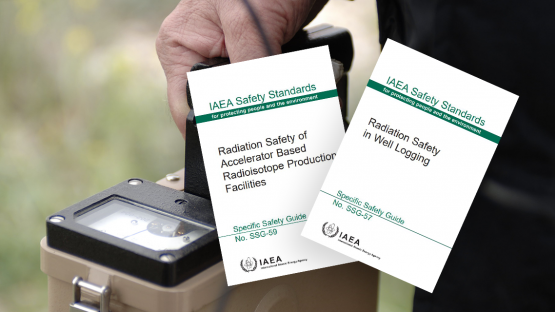Radiation safety in well logging, a process which is carried out as part of exploration activities for oil, gas and minerals as well as in groundwater studies, is addressed in Radiation Safety in Well Logging (SSG-57). Radioactive sealed sources or neutron generators, known as logging tools, are an integral part of the equipment used in well logging. Logging tools are lowered into a borehole, drilled into the ground, and utilized to map the underground geology - just like an X-ray is used to scan the inside of the human body.
As well logging often takes place in remote environments on land or at sea, the handling, storage and transportation of logging tools is carefully managed to avoid them getting damaged in the borehole and becoming irretrievable. Without advance planning and a strong on-site safety culture, there is risk of radiation exposure to workers and the environment.
SSG-57 provides guidance on the use of radioactive sources and radiation generators in all aspects of well logging, including in the manufacture, calibration and maintenance of well logging tools. The safety guide offers guidance to regulatory bodies, designers, manufacturers, suppliers and maintenance and servicing organizations of well logging equipment to enhance radiation protection and safety throughout the lifetime of such devices.
Radiation Safety of Accelerator Based Radioisotope Production Facilities (SSG-59) offers solutions to improve radiation protection in radioisotope production. Radioisotopes are beneficial in a range of medical, industrial, research and academic applications, but the production of radioisotopes can pose radiation hazards when accelerators are operated without adequate safety measures. As the number of institutions that operate linear accelerators and manufacture radiopharmaceuticals is increasing, the IAEA developed SSG-59 to help ensure the operators of production facilities have the knowledge necessary to operate safely.
SSG-59 presents practical guidance for implementing radiation protection and safety measures in facilities involved in the production and use of radioisotopes. This safety guide covers individual and workplace monitoring for radioisotope production facilities, the duties and responsibilities of the various parties involved in radioisotope production, environmental concerns including waste management.
It is part of the IAEA’s mandate to assist Member States with the adoption of the IAEA Safety Standards. These serve as a global reference for protecting people and the environment and contribute to a harmonized high level of safety worldwide. Experts and authorities are encouraged to utilize these recommendations to enhance and further develop national regulations on the protection of workers, the public and the environment, Pinak highlighted.



